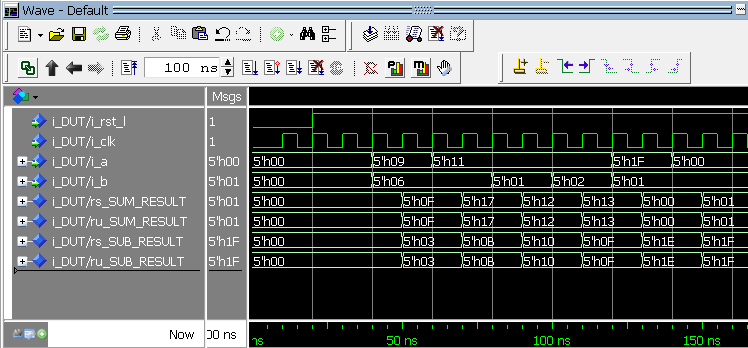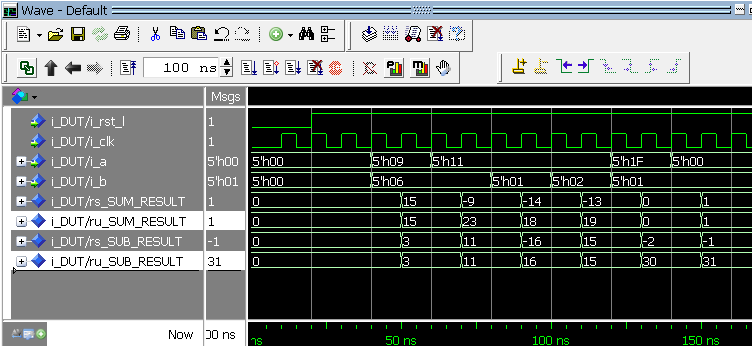VHDL 中的有符号与无符号
所有数字设计师都必须了解 FPGA 或 ASIC 内部的数学原理。第一步是了解有符号和无符号信号类型是如何工作的。 numeric_std 中存在有符号和无符号类型 包,它是 ieee 库的一部分。需要注意的是,还有一个包文件经常被用来进行数学运算:std_logic_arith .但是,std_logic_arith 不是官方 ieee 支持的包文件,不建议在数字设计中使用。
定义为 signed 类型的信号 意味着工具将此信号解释为正面或负面。定义为 unsigned 类型的信号 意味着信号只会是积极的。在内部,FPGA 将使用 Two's Complement 表示。例如,一个 3 位的信号可以根据下表来解释:
你还迷茫吗?你应该是,这不直观!让我们看一个希望能把事情弄清楚的例子。下面的文件测试了有符号无符号的工作原理。需要理解的是信号是否定义为有符号或无符号不是 影响实际二进制数学的执行方式。
例如:对于两个有符号向量 10001 + 00010,答案仍然是 10011,但它是 解释 的结果是不同的。
对于未签名的情况,答案 (10011) 代表 19。
对于已签名的情况,答案 (10011) 表示 -13。
library ieee;
use ieee.std_logic_1164.all;
use ieee.numeric_std.all;
entity signed_unsigned is
port (
i_rst_l : in std_logic;
i_clk : in std_logic;
i_a : in std_logic_vector(4 downto 0);
i_b : in std_logic_vector(4 downto 0)
);
end signed_unsigned;
architecture behave of signed_unsigned is
signal rs_SUM_RESULT : signed(4 downto 0) := (others => '0');
signal ru_SUM_RESULT : unsigned(4 downto 0) := (others => '0');
signal rs_SUB_RESULT : signed(4 downto 0) := (others => '0');
signal ru_SUB_RESULT : unsigned(4 downto 0) := (others => '0');
begin
-- Purpose: Add two numbers. Does both the signed and unsigned
-- addition for demonstration. This process is synthesizable.
p_SUM : process (i_clk, i_rst_l)
begin
if i_rst_l = '0' then -- asynchronous reset (active low)
rs_SUM_RESULT <= (others => '0');
ru_SUM_RESULT <= (others => '0');
elsif rising_edge(i_clk) then
ru_SUM_RESULT <= unsigned(i_a) + unsigned(i_b);
rs_SUM_RESULT <= signed(i_a) + signed(i_b);
end if;
end process p_SUM;
-- Purpose: Subtract two numbers. Does both the signed and unsigned
-- subtraction for demonstration. This process is synthesizable.
p_SUB : process (i_clk, i_rst_l)
begin
if i_rst_l = '0' then -- asynchronous reset (active low)
rs_SUB_RESULT <= (others => '0');
ru_SUB_RESULT <= (others => '0');
elsif rising_edge(i_clk) then
ru_SUB_RESULT <= unsigned(i_a) - unsigned(i_b);
rs_SUB_RESULT <= signed(i_a) - signed(i_b);
end if;
end process p_SUB;
end behave;
测试台:
library ieee;
use ieee.std_logic_1164.all;
entity example_signed_unsigned_tb is
end example_signed_unsigned_tb;
architecture behave of example_signed_unsigned_tb is
--Registers
signal r_CLK : std_logic := '0';
signal r_RST_L : std_logic := '0';
signal r_A : natural := 0;
signal r_B : natural := 0;
signal r_A_SLV : std_logic_vector(4 downto 0) := (others => '0');
signal r_B_SLV : std_logic_vector(4 downto 0) := (others => '0');
constant c_CLK_PERIOD : time := 10 ns;
component example_signed_unsigned is
port (
i_rst_l : in std_logic;
i_clk : in std_logic;
i_a : in std_logic_vector(4 downto 0);
i_b : in std_logic_vector(4 downto 0)
);
end component example_signed_unsigned;
begin
i_DUT: example_signed_unsigned
port map (
i_rst_l => r_RST_L,
i_clk => r_CLK,
i_a => r_A_SLV,
i_b => r_B_SLV
);
clk_gen : process is
begin
r_CLK <= '0' after c_CLK_PERIOD/2, '1' after c_CLK_PERIOD;
wait for c_CLK_PERIOD;
end process clk_gen;
process
begin
r_RST_L <= '0';
wait for 20 ns;
r_RST_L <= '1';
wait for 20 ns;
r_A_SLV <= "01001";
r_B_SLV <= "00110";
wait for 20 ns;
r_A_SLV <= "10001";
r_B_SLV <= "00110";
wait for 20 ns;
r_A_SLV <= "10001";
r_B_SLV <= "00001";
wait for 20 ns;
r_A_SLV <= "10001";
r_B_SLV <= "00010";
wait for 20 ns;
r_A_SLV <= "11111";
r_B_SLV <= "00001";
wait for 20 ns;
r_A_SLV <= "00000";
r_B_SLV <= "00001";
wait for 20 ns;
wait;
end process;
end behave;
 Modelsim仿真波输出值以十六进制显示
Modelsim仿真波输出值以十六进制显示
 Modelsim 模拟波输出值以十进制显示
Modelsim 模拟波输出值以十进制显示 比较上面的两个modelsim截图。在第一个你可以看到 results 以十六进制表示时,数学函数的数量完全相同。这是解释 的结果是不同的。这可以通过查看底部屏幕截图来看到。当 Modelsim 以十进制显示结果时,它会将其中的一些解释为负数。使用有符号和无符号类型时,您必须非常小心!希望你能更好地理解这个话题。我觉得这是许多数字设计师都在努力解决的一个领域,所以如果有什么你不完全理解的东西,请通过侧边栏上的联系链接给我发电子邮件,我会尽量把它说得更清楚。
VHDL


